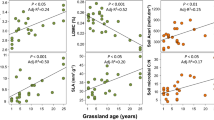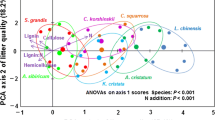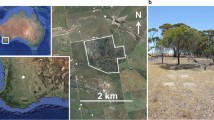Abstract
Direct physical interference from litter is an important mechanism driving changes in the diversity and composition of plant communities dominated by perennial species. While the consequences of litter for species diversity and composition are well known, the mechanisms shaping how litter acts as a filter on leaf and shoot functional traits to alter community structure and functional diversity remain unclear. These questions were examined using a large field experiment in native mixed-grass prairie grasslands in the brown and dark brown soil zones in central Saskatchewan, Canada. Litter additions ranging from 0 to 2,290 g m−2 were applied to plots in a response surface design, and responses including community structure, above-ground functional diversity, and community-weighted mean values for leaf functional traits were measured. Species richness, functional richness, and functional dispersion declined with increasing litter mass, but functional evenness increased. Community composition became more variable because increased litter acted as a filter on the perennial species previously present in the plots; the remaining species in a given plot were the most litter-tolerant subset of the original community in the plot. Increased litter mass affected graminoid and forb species differently. Increased litter mass selected for graminoid species characterized by greater height, leaf area, specific leaf area (SLA), leaf thickness, and leaf tissue density. In contrast, increased litter selected for forb species characterized by larger, thicker leaves, lower SLA, and lower leaf tissue density. Forbs with cauline leaves were also selected for over acaulescent growth forms. Physical interference by litter likely reduces grassland diversity and alters species composition in diverse grassland communities by forcing convergence in community trait structure, but not convergence in species composition.




Similar content being viewed by others
References
Acton DF, Padbury GA, Stushnoff CT (1998) The ecoregions of Saskatchewan. University of Regina, Canadian Plains Research Center. Regina, SK.: 205 p
Amatangelo KL, Dukes JS, Field CB (2008) Responses of a California annual grassland to litter manipulation. J Veg Sci 19:605–612
Cadotte MW, Carscadden K, Mirotchnick N (2011) Beyond species: functional diversity and the maintenance of ecological processes and services. J Appl Ecol 48:1079–1087
Campbell CA, Souster W (1982) Loss of organic matter and potentially mineralizable nitrogen from Saskatchewan soils due to cropping. Can J Soil Sci 62:651–656
Carson W, Peterson C (1990) The role of litter in an old-field community: impact of litter quantity in different seasons on plant species richness and abundance. Oecologia 85:8–13
Cid MS, Brizuela MA (1998) Heterogeneity in tall fescue pastures created and sustained by cattle grazing. J Range Manag 51:644–649
Cottingham KL, Lennon JT, Brown BL (2005) Knowing when to draw the line: designing more informative ecological experiments. Front Ecol Environ 3:145–152
Coupland RT (1950) Ecology of mixed prairie in Canada. Ecol Monogr 20:271–315
Coupland RT, Brayshaw TC (1953) The fescue grassland in Saskatchewan. Ecology 34:386–405
Craine JM, Froehle J, Tilman DG, Wedin DA, Chapin IFS (2001) The relationships among root and leaf traits of 76 grassland species and relative abundance along fertility and disturbance gradients. Oikos 93:274–285
Deutsch E, Bork E, Willms WD (2010a) Separation of grassland litter and ecosite influences on seasonal soil moisture and plant growth dynamics. Plant Ecol 209:135–145
Deutsch ES, Bork EW, Willms WD (2010b) Soil moisture and plant growth responses to litter and defoliation impacts in Parkland grasslands. Agric Ecosyst Environ 135:1–9
Diaz S, Cabido M (2001) Vive la différence: plant functional diversity matters to ecosystem processes. Trends Ecol Evol 16:646–655
Dijkstra P, Lambers H (1989) Analysis of specific leaf area and photosynthesis of two inbred lines of Plantago major differing in relative growth rate. New Phytol 113:283–290
Donath TW, Eckstein RL (2008) Grass and oak litter exert different effects on seedling emergence of herbaceous perennials from grasslands and woodlands. J Ecol 96:272–280
Ellis JG, Acton DF, Moss HC (1970) The soils of the Rosetown map area (720), Saskatchewan. Saskatoon Institute of Pedology, Saskatoon
Foster BL, Gross KL (1998) Species richness in a successional grassland: effects of nitrogen enrichment and plant litter. Ecology 79:2593–2602
Grime JP, Thompson K, Hunt R, Hodgson JG, Cornelissen JHC, Rorison IH, Hendry GAF, Ashenden TW, Askew AP, Band SR, Booth RE, Bossard CC, Campbell BD, Cooper JEL, Davison AW, Gupta PL, Hall W, Hand DW, Hannah MA, Hillier SH, Hodkinson DJ, Jalili A, Liu Z, Mackey JML, Matthews N, Mowforth MA, Neal AM, Reader RJ, Reiling K, Ross-Fraser W, Spencer RE, Sutton F, Tasker DE, Thorpe PC, Whitehouse J (1997) Integrated screening validates primary axes of specialisation in plants. Oikos 79:259–281
Gross DV, Romo JT (2010) Burning history, time of burning, and year effects on plant community structure and heterogeneity in Fescue Prairie. Botany 88:1–12
Guedo DD, Lamb EG (2013) Temporal changes in abundance–occupancy relationships within and between communities after disturbance. J Veg Sci 24:607–615
Hooper DU, Chapin FS, Ewel JJ, Hector A, Inchausti P, Lavorel S, Lawton JH, Lodge DM, Loreau M, Naeem S, Schmid B, Setala H, Symstad AJ, Vandermeer J, Wardle DA (2005) Effects of biodiversity on ecosystem functioning: a consensus of current knowledge. Ecol Monogr 75:3–35
Hovstad K, Ohlson M (2008) Physical and chemical effects of litter on plant establishment in semi-natural grasslands. Plant Ecol 196:251–260
Jensen K, Gutekunst K (2003) Effects of litter on establishment of grassland plant species: the role of seed size and successional status. Basic Appl Ecol 4:579–587
Kembel SW, Cahill JF Jr (2011) Independent evolution of leaf and root traits within and among temperate grassland plant communities. PLoS ONE 6:e19992
Laliberte E, Legendre P (2010) A distance-based framework for measuring functional diversity from multiple traits. Ecology 91:299–305
Lamb EG (2008) Direct and indirect control of grassland community structure by litter, resources, and biomass. Ecology 89:216–225
Lavorel S, Grigulis K, McIntyre S, Williams NSG, Garden D, Dorrough J, Berman S, Quétier F, Thébault A, Bonis A (2008) Assessing functional diversity in the field – methodology matters! Funct Ecol 22:134–147
Lingoes J (1971) Some boundary conditions for a monotone analysis of symmetric matrices. Psychometrika 36:195–203
Loreau M, de Mazancourt C (2013) Biodiversity and ecosystem stability: a synthesis of underlying mechanisms. Ecol Lett 16:106–115
Loydi A, Eckstein RL, Otte A, Donath TW (2013) Effects of litter on seedling establishment in natural and semi-natural grasslands: a meta-analysis. J Ecol 101:454–464
Moss EH (1983) Flora of Alberta. Toronto University Press, Toronto
Mouillot D, Graham NAJ, Villéger S, Mason NWH, Bellwood DR (2013) A functional approach reveals community responses to disturbances. Trends Ecol Evol 28:167–177
Oksanen JF, Blanchet G, Kindt R, Legendre P, Minchin PR, O’Hara RB, Simpson GL, Solymos P, Stevens MHH, Wagner H (2011) vegan: community ecology package v.2.0-2
Pakeman RJ (2011) Functional diversity indices reveal the impacts of land use intensification on plant community assembly. J Ecol 99:1143–1151
Pinheiro J, Bates D, DebRoy S, Sarkar D, R Development Core Team (2012) nlme: Linear and nonlinear mixed effects models. R package version 3.1-104
Pokorny ML, Sheley RL, Zabinski CA, Engel RE, Svejcar TJ, Borkowski JJ (2005) Plant functional group diversity as a mechanism for invasion resistance. Restor Ecol 13:448–459
R Development Core Team (2012) R: a language and environment for statistical computing. R foundation for statistical computing, Vienna, Austria
Reich PB, Walters MB, Ellsworth DS (1997) From tropics to tundra: global convergence in plant functioning. Proc Natl Acad Sci USA 94:13730–13734
Ruprecht E, Enyedi MZ, Eckstein RL, Donath TW (2010a) Restorative removal of plant litter and vegetation 40 years after abandonment enhances re-emergence of steppe grassland vegetation. Biol Conserv 143:449–456
Ruprecht E, Józsa J, Ölvedi TB, Simon J (2010b) Differential effects of several “litter” types on the germination of dry grassland species. J Veg Sci 21:1069–1081
Smith B, Wilson JB (1996) A consumer’s guide to evenness indices. Oikos 76:70–82
Soil Classification Working Group (1998) Canadian system of soil classification. Agriculture and Agri-food Canada, Ottawa
Stirling G, Wilsey B (2001) Empirical relationships between species richness, evenness, and proportional diversity. Am Nat 158:286–299
Tannas K (2004) Common plants of the western rangelands. Alberta Agriculture, Food, and Rural Development, Edmonton, AB
Villéger S, Mason NWH, Mouillot D (2008) New multidimensional functional diversity indices for a multifaceted framework in functional ecology. Ecology 89:2290–2301
Weiher E, Keddy PA (1999) Relative abundance and evenness patterns along diversity and biomass gradients. Oikos 87:355–361
Willms WD, Smoliak S, Bailey AW (1986) Herbage production following litter removal on Alberta native grasslands. J Range Manag 39:536–540
Willms WD, Dormaar JF, Schaalje GB (1988) Stability of grazed patches on rough fescue grasslands. J Range Manag 41:503–508
Willms WD, McGinn SM, Dormaar JF (1993) Influence of litter on herbage production in the Mixed Prairie. J Range Manag 46:320–324
Wilsey B, Stirling G (2007) Species richness and evenness respond in a different manner to propagule density in developing prairie microcosm communities. Plant Ecol 190:259–273
Xiong S, Nilsson C (1999) The effects of plant litter on vegetation: a meta-analysis. J Ecol 87:984–994
Acknowledgments
Funding for this project came from a Saskatchewan Agriculture Development Fund grant (20090262) to J.T.R., E.G.L., and Yuguang Bai and an NSERC Discovery Grant to E.G.L. Thanks are extended to Jeremy Simpson, Manager of the Matador Community Pasture, Luke Ellingson, Manager of the Monet Community Pasture, and the Patrons of the King George Grazing Co-Op for site access. P.A. Ryan provided supervision and organization throughout all phases of research and S.W. Kembel provided trait data. We thank A. Johnson, Y. Wei, X. Tian, J. Li, K. Aikens, L. Wang, K. Ellingson, and N. Poulin for assistance.
Author information
Authors and Affiliations
Corresponding author
Additional information
Communicated by Jodi Price.
Electronic supplementary material
Below is the link to the electronic supplementary material.
Rights and permissions
About this article
Cite this article
Letts, B., Lamb, E.G., Mischkolz, J.M. et al. Litter accumulation drives grassland plant community composition and functional diversity via leaf traits. Plant Ecol 216, 357–370 (2015). https://doi.org/10.1007/s11258-014-0436-6
Received:
Accepted:
Published:
Issue Date:
DOI: https://doi.org/10.1007/s11258-014-0436-6




